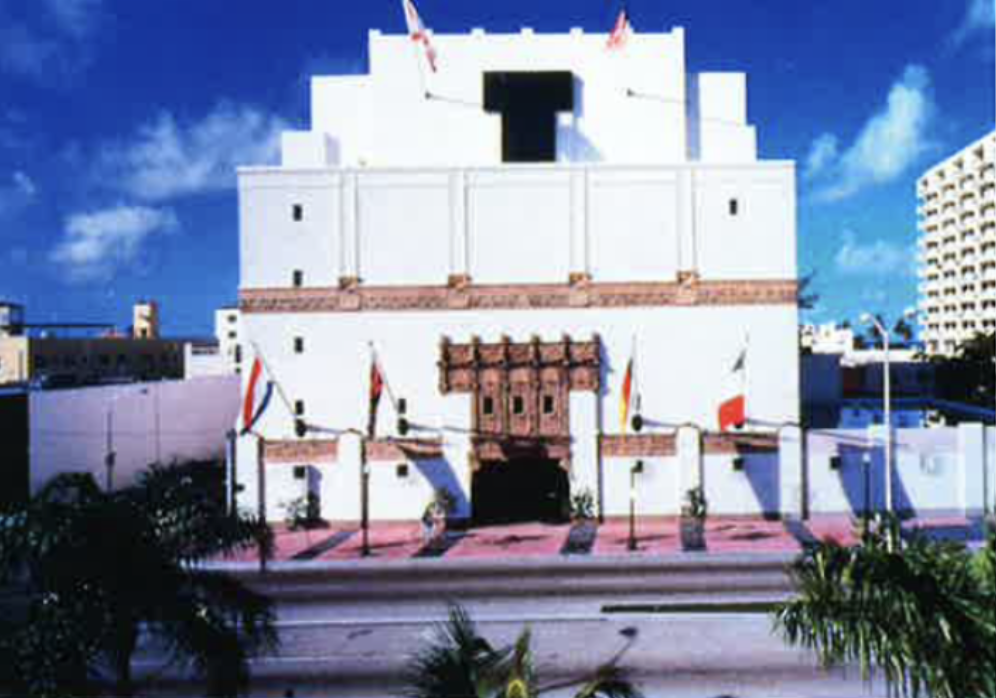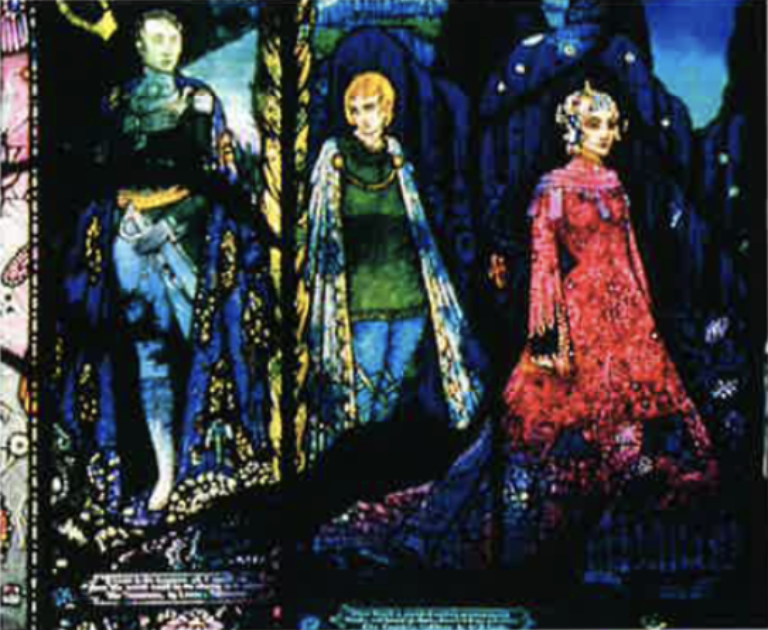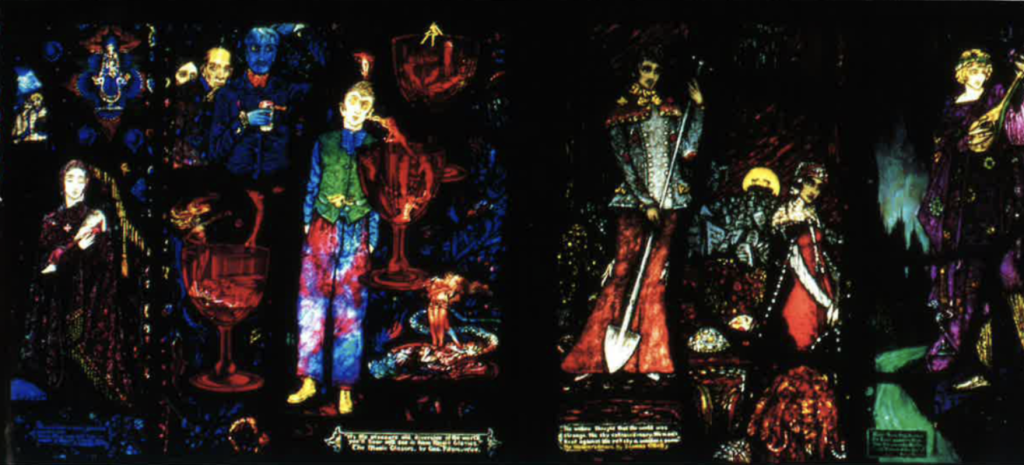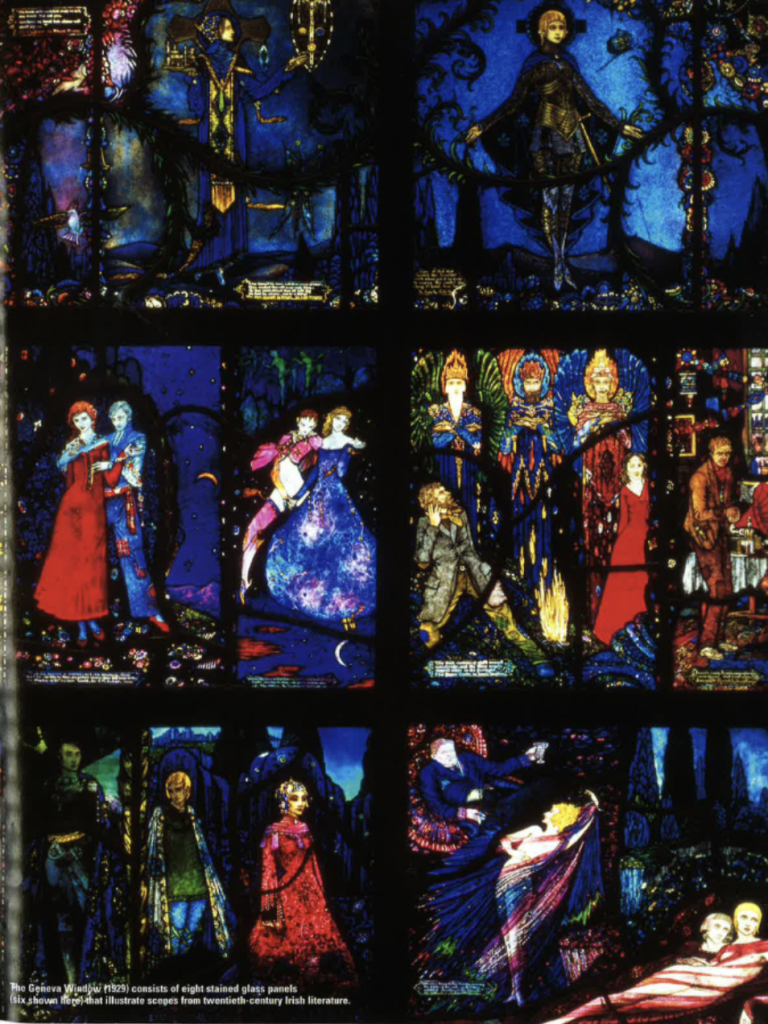The Geneva Window, created by Harry Clarke, Ireland’s greatest stained-glass artist, finds a home in Miami.
The Countess Cathleen is breathtaking, her brocaded gown glowing with the light of a million rubies. Joxer Daley rubs his hands together as he gazes shrewdly beyond us, a bottle of stout set next to the red horn of the victrola behind him. The Western world’s notorious Playboy, in much-patched pants, has his arm around Pegeen Mike St. Joan stands straight and true, a Celtic cross forming her halo.
In short, a pantheon of the characters of the great Irish authors of the early part of this century radiates before us, trapped shimmering in one glorious window by Ireland’s greatest stained-glass artist, Harry Clarke.
Sixty-five years after it was spurned by a red-faced Irish government, this controversial masterpiece has just gone on exhibit in its first permanent home- a museum in Miami Beach, 4,000 miles from the land it celebrates.
The exhibition at the Wolfsonian Museum is likely to bring a pang of loss to art lovers in Ireland. But it marks an end to a long, dark journey for a brilliant piece of art. It means that the work, finally, will be viewed by the international audience it was designed for and deserves.

And it gives the public a new opportunity to appreciate the bright talent of the imaginative Irishman who died soon after creating the window. His ornate, exquisite stained-glass creations cast an illuminating light on Irish tradition. They can be viewed throughout Ireland. But until now they could be seen only in one place in America, a church in Bayonne, New Jersey.
Known as the Geneva Window, the unsettling Irish-literature stained-glass was produced at the invitation of the government of the Irish Free State. Independent for less than a decade, the nation was eager to show off its heritage to the rest of the world. One way was to donate the window by Clarke-whose mystical Celtic Revival creations already had turned the staid stained-glass world on its head-to the International Labor Office at the new League of Nations headquarters in Switzerland.
Clarke and the government agreed that the piece would honor modem Irish literature. There, however, the artist and the patron parted ways. When the window was finished, there was a profound gap between them.
The completed window-eight separate panels arranged in a six-by-three-foot frame-pictured scenes from the works of such writers as Yeats, Joyce, Synge, O’Casey and Liam O’Flaherty in dazzling designs and intense colors.
But those panels also included some features that brought blushes to the cheeks of a number of Irish leaders: a semi-nude dancer, a drunken-looking lout, even that bottle of stout.
Were these scenes-decidedly unpastoral and something less than heroic-the way the Irish Free State wanted to present itself to the rest of the world? Was this the kind of creation it wanted to show to its own people? The politicians, with little ado, harrumphed and shook their heads.
Nakedness was something they were prepared to accept as an artistic requirement, but never nakedness which so suggested sex,” Clarke’s son later quoted a government official as saying.
A letter to Clarke from Irish President William Cosgrave put it more diplomatically: “You will appreciate that my difficulty has nothing to do with the artistic merit of the panel: it arises from the fact that the inclusion of scenes from certain authors as representative of Irish literature and culture would give grave offense to many of our people.”
Clarke, long ill with tuberculosis, died as the controversy swirled around him. He was only 41. His widow, Margaret, a painter, spent two years fighting to convince the government to send the window to Geneva, or at least to sell it back to her. Finally, after a change in ruling parties, she was able to pay the original £400 fee back to the government and collect the master-piece.
Margaret kept it at the Clarke studios until her death in 1961. Later, the Clarke children lent it for a time to the Hugh Lane Municipal Gallery in Dublin. But they weren’t happy with the way it was displayed, and it was packed up and returned to the sons.
Thus, for most of its existence, this dazzling culmination of the work of Ireland’s premier stained-glass artist has lain hidden and dark.
The shadows began to lift in 1988, when an exhibition, “The Stained Glass of Harry Clarke,” was staged in London by the Fine Arts Society. The Geneva Window was the hit of the show – and, at the same time, word went out that it was for sale.
Mitchell Wolfson, Jr., a wealthy American collector, wasted no time. He swiftly bought it-reportedly for a quarter-million dollars-for his new Wolfsonian Museum in Miami Beach.

The window fit perfectly with the museum’s focus on decorative and propaganda arts. “One of Mr. Wolfson’s interests,” explains Marianne Lamonaca, associate curator of the Wolfsonian, “is Romantic nationalism-the idea of a country representing its heritage through design.”
So the Geneva Window will be part of the Wolfsonian’s inaugural exhibition, “The Arts of Reform and Persuasion, 1885-1945.”
Many Irish may be unhappy over the window’s emigration; the Irish Times wrote when it was sold, “We have, quite simply, disgraced ourselves once again.” But it was, after all, originally meant to be sent out of Ireland. And Clarke was eager to gain the international reputation his output deserved.
Born on St. Patrick’s Day in 1889, Harry Clarke literally grew up in a world of stained glass. His father, Joshua, owned a North Dublin firm that created and supplied stained glass to churches. Harry began learning the craft in his father’s studios as a teenager. He had already exhibited a remarkable talent for drawing.
By his early 20s, Harry Clarke was an accomplished illustrator and stained-glass artist. Over the next 20 years, he turned out a prodigious quantity of windows-largely for Irish churches, where most still can be viewed-and illustrated several books with striking drawings.
His characters bear something of stylistic resemblance to the drawings of Aubrey Beardsley: willowy figures with long, solemn faces and powerful eyes, placed before ornate, exotic backgrounds.
The scenes often come from a mix of Irish history, early Irish saints and legend, like St. Brendan the Navigator meeting an eternally burning Judas on a remote island, or St. Gobnait, patron saint of beekeepers, or St. Dymphna, whose pagan father had her beheaded.
Clarke had an eye for the ugly side of humanity. The minor characters in his windows-would-be thieves fleeing St. Gobnait’s avenging bees, St. Dymphna’s executioner, the mobs jeering Christ on his way to Calvary-are masterpieces of the macabre and bizarre. (Not did Clarke hold himself above humanity; in his mammoth triple window at Newport, County Mayo depicting the Last Judgment, a green-skinned Harry Clarke is among the sinners being cast into hell.)
The books he illustrated included works by Edgar Allan Poe, an ideal combination of author and artist.
As striking as his drawing style was his use of color. Standard stained-glass windows, like those found in countless churches, literally pale in comparison with the hues of Clarke’s works. Their ordinary shades are blander and flatter, like a print on a curtain that’s faded from time and sunlight; Clarke’s windows sparkle with iridescent midnight blues, burning reds and lustrous greens. His luminous colors set flowing robes in motion and transform border details into jewels.
Much of Clarke’s stained-glass was a visual celebration of the Celtic Revival, of the Irish re-discovery of themselves and their heritage. The artist lived during a tumultuous time when the Irish language flowered again, the Abbey Theatre was founded, Patrick Pearse led the Easter Rising, and Yeats described the terrible beauty that was born.
Appropriately, Clarke catapulted to fame with his first church commission. It was for some of the windows in a perfect architectural jewel of the Celtic Revival, the Honan Chapel at University College, Cork. The small chapel is a replica of an idealized 12th-century Irish church that features stone carvings, an imaginative mosaic floor and carved oak pews. Clarke’s windows focus on such ancient Irish saints as Patrick, Colmcille, Brigid, FinnBar (the founder of Cork), Declan and Brendan.
But most of Clarke’s windows are in more ordinary settings-churches throughout Ireland and, to a lesser extent, Britain. There they were something more basic than art, a Clarke devotee named the Rev. Colm Connellan, now deceased, explained a few years ago. They were the audio-visual aids of the pre-video day. And they were vivid and potent communication tools, added the priest at Co. Dublin’s Belcamp College, where the chapel is full of Clarke’s windows depicting Irish saints-windows Father Connellan first saw in 1935 as a youth.
The Geneva Window meant to do for Ireland on an international secular scene the kind of communicating the church windows did on a religious one. But it never really got the chance.
Its belated official introduction to the world, at the Wolfsonian, comes after conservation work by New York’s Mary Clerkin Higgins. The glass basically was in good condition because it had not been exposed to the weather, as most stained glass would be.

However, Clarke’s methods were hard on glass. Since he both etched and fired the glass, stress had made some pieces crack in such a way that they no longer lined up correctly. Dust had settled between the double-plated layers. Parts of Clarke’s meticulous etching had filled in with dirt, eliminating the sparkling effect. But painstaking repair, careful cleaning and tender loving care have restored the masterpiece to its original quality.
The Geneva Window went on exhibition at the opening of the Wolfsonian, at 1001 Washington Avenue, Miami Beach, on November 11, 1995. The exhibition closes April 28, 1996. Then it will travel around the country and across the globe. In the U.S., it will stop at the Los Angeles County Museum of Art from July 21, 1996 to Sept. 22, 1996; the Seattle Art Museum, Oct. 24, 1996 to Jan. 12, 1997; the Carnegie Museum of Art in Pittsburgh, Feb. 22, 1997 to May 18, 1997; and the Indianapolis Museum of Art, Nov. 15 1997 to Feb. 1, 1998. Then it will return to the Wolfsonian’s marvelous old building among the Art Deco structures of Miami Beach.
Clarke’s works can be found in only one other place in the United States-at the Basilica of St. Vincent de Paul in Bayonne, New Jersey, where they’re a bit too high for full appreciation. (The rest of the church’s windows are by the Clarke studios and, though lacking Clarke’s genius, are still beautiful.)
Visitors to Ireland can find fine Clarke windows throughout the country. Outstanding examples include windows at the Catholic churches of Newport, Co. Mayo (the stunning Last Judgment); St. Joseph, Terenure, Co. Dublin; Carrickmacross, Co. Monaghan; Ballinasloe, Co. Galway; Cloughjordan, Co. Tipperary, and the Honan Chapel. There’s also St. Barrahane’s Church of Ireland church in Castletownsend, Co. Cork; the Presbyterian Church in Clontarf, just north of Dublin; and the Church of Ireland church on Sandford Road in Ranelagh, just south of Dublin. (Non-Catholic churches, however, are often closed except for services.)
With a little more effort-basically, just a telephone call ahead-Clarke’s windows can be viewed at Belcamp College (located just off the main road at Raheny, north of Dublin); the chapel a the Presentation Convent in Dingle, Co. Kerry; and the Dominican Convent Chapel on the Falls Road in Belfast.
With a great deal of effort, 14 marvelous Clarke windows can be viewed at the Basilica of St. Patrick’s Purgatory on Station Island in Lough Derg, Co. Monaghan. Unless you want to join a grueling, three-day mass pilgrimage, you must request special permission well in advance from the Prior, located at Pettigo, Co. Donegal. There’s a special reward, however: unlike most church windows, these are placed at eye level, allowing full and easy appreciation of the artistry.
But churches aren’t the only places to see Clarke’s work in Ireland. A well-displayed handful of stunning early pieces is at the Crawford Municipal Art Gallery at Emmet Place in Cork.
A non-religious masterpiece, the multipanel depiction of Keats’ poem “The Eve of St. Agnes,” is finally back on display in Dublin at the Municipal Gallery of Art after a hiatus of several years.
And perhaps the most widely seen Clarke windows are at the vast Bewley’s Oriental Cafe on Grafton Street. They’re simple decorative patterns, rather than full-blown illustrations, but they’re no less fabulous for that.
Clarke’s friend, the writer Lennox Robinson, wrote at his death, “People who write books and plays and poems have their work put away on shelves where it may lie for years, unopened and unread. Harry Clarke in the east end or transept of many a church in Ireland and elsewhere comes to life with every dawn and will have his daily resurrection.”
Editor’s Note: This article was originally published in the March/April 1996 issue of Irish America. ⬥


Leave a Reply